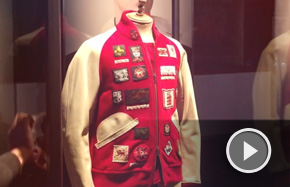Calligrapher with revolutionary inspiration
He also blends Japanese colors with the beauty of lines found in traditional Chinese paintings
His rough face shows just how much suffering he's endured, his long, grey hair shows how much difficulty he's been through, but he's also one of China's most influential calligraphers.
And, low-keyed though he appears to be, Wang Deshui is a painter who has integrated traditional Chinese notions of painting with more recent Western ideas.
Wang was born in the city of Shaoxing, Zhejiang province, in 1954 and is the distant descendant of Wang Xizhi, one of the nation's greatest calligraphers, who lived during the Eastern Jin Dynasty (317-420).
Wang studied Chinese calligraphy and painting at a very early age and learned the essence of the traditional arts. He traveled to Japan in 1987 to study Japanese painting, something that allowed him to blend colors, a characteristic of Japanese painting, and the beauty of lines found in traditional Chinese painting.
Wang is now the chairman of the Southeast Asian Nations Culture and Art Exchange Association, Japan's Chinese Calligraphy and Painting Research Institute, and a visiting professor at Shanghai University and Shanghai Normal University.
Wang's masterpieces are mostly portraits but there are also distinctive features in his flowers, landscapes and animals.
His works are appreciated by art experts, critics, and painting lovers. Critics say that his works shows a solid foundation and an easy control of ink and colors, with a strong sense of modern beauty at the same time.
He now lives in Tokyo, Japan, but hopes to "return home via art" and has held exhibitions since the 1990s in China and a number of Japanese cities such as Tokyo, Kyoto, Kobe and Osaka.
One of his latest art shows is scheduled for mid-June in Hunan province, to mark the 90th anniversary of the Communist Party of China.
This past year, Wang has visited Hunan, home of the revolutionary figures of the 20th century, such as Mao Zedong, Liu Shaoqi and Ren Bishi, to seek inspiration.
"Hunan is the hometown of the great men. For Chairman Mao, I feel great admiration," he said.
He did some 99 works of calligraphy and painting during his visit to Hunan. The calligraphy is mostly based on Mao Zedong's poetry, and the paintings are portraits of revolutionary figures and depicture the province's natural beauty.






















